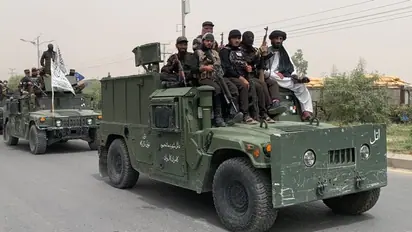Special Series Part-I: The dilemma for Taliban in terror haven

Synopsis
Terror organizations, their networks and their power struggles, and the emerging crises from time to time are taking a toll on Afghanistan, which has turned into a haven for terrorist outfits. In this special series, Prof (Dr) Nishakant Ojha, an eminent expert in counter Terrorism (West Asia and Middle East), delves deeper into the present critical situation in Afghanistan.
Before the return of the Taliban to power on 15th August 2021, it was widely propagated, particularly by specific circles in the United States, Pakistan and Russia that the new Taliban are not the same as the old version of the 1990s. They argued that the new Taliban, having been exposed to global realities, is more open-minded on the issues of rights and liberties. The political office of the Taliban also advertised that it had learnt many lessons but insisted that all their policies and practices will still be in accordance with the Islamic Sharia.
Before coming back to power, the Taliban and their well-wishers exacerbated their campaign of demonstrating that the Taliban are a changed group. The Taliban political office also claimed that they now believe in inclusivity and that they will let women attend schools and colleges while allowing them to work and participate in political and cultural activities while adhering to Sharia and Afghan customs and traditions.
Now that they are in power again, they prevented girls from going to school and work. They forced men to grow longer beards and attend prayers at the mosque five times a day. Their government is even less inclusive than their previous incarnation. Their critics agree that the Taliban have changed but mostly in the wrong direction.
The second layer of a possible re-escalation of conflict in Afghanistan is between the Islamic Emirate of Afghanistan and Daesh. This conflict had already commenced before NATO’s withdrawal from Afghanistan. Daesh continues to become stronger, as the more extremist elements within the Taliban are resistant to the idea of giving up fighting. They want to continue fighting and are thus defecting in large numbers to Daesh. Furthermore, to save their lives and to take revenge on the Taliban, many former ANDSF fighters are also joining Daesh.
The foreign fighters that were embedded in the Taliban who now want to export Jihad to other countries are disappointed with the Taliban’s stance of not facilitating terrorist attacks in other countries. Many of these foreign fighters continue to defect to Daesh, thus further empowering the group. Another opportunity for Daesh is rampant poverty. If Daesh can pay and feed starving youth, then thousands of them will join Daesh. And not only Deash there are severe repercussions and strategic alliance with other existing terrorist Groups in Afghanistan they may be pro-and-against Taliban.
Expanding Terrorist Organizations in Afghanistan
Afghanistan continues to be home to the enemies of most countries in the region. Many such groups that are based in Afghanistan are officially declared regional terrorist groups, some of which are operating as extensions of the Taliban. They assisted the Taliban in defeating the Afghan National Defence and Security Forces (ANDSF) and overthrowing the Islamic Republic of Afghanistan (IRA).
Now these transnational terrorist groups such as ETIM (China), IMU (Uzbekistan), TTP (Pakistan) and Jamaat Ansarullah (Tajikistan) to name a few out of at least two dozen groups, want to seize the opportunity and commence Jihad in their own countries with the aim of establishing regimes that are similar to the Taliban’s Islamic Emirate of Afghanistan and Daesh’s Islamic State. They want the Taliban to actively assist them in the militant campaigns that they call Jihad in their own countries, just as they had assisted the Taliban from 2001 until 2021. There are reports that the above-mentioned groups have already infiltrated from Takhar into the Ferghana Valley, all the way up to Kyrgyzstan and Kazakhstan.
This developing situation has created a dilemma for the Taliban. If they assist these groups, it will slow down their hopes of diplomatic recognition and possibly cut short their tenure in power. If the Taliban ignore the expectations of these regional terror groups, it will likely lead to the commencement of another series of violence inside Afghanistan. These groups may side with and strengthen anti-Taliban militant groups in Afghanistan, including, but not limited to the Islamic State in Khorasan (IS-K). The early signs of such a scenario are already visible on the ground. The suicide attack in a mosque in Kunduz in October 2021 was reportedly conducted by an ethnic Uyghur from China, possibly a member of ETIM. Many subsequent suicide bombings in Taliban-ruled Afghanistan, including the attacks in Kabul, were conducted by nationals from Tajikistan.
There is a strong possibility that many of the fighters of the regional terrorist groups in Afghanistan may independently (without the Taliban’s assistance) move to their own countries and commence new phases of terrorist activities there -- resulting in the destabilisation of the region. Central Asian States are the most vulnerable in this respect. Many Central Asian states are more fearful of the spread of the Taliban’s ideology into their countries than they are of the spread of the actual fighters from Afghanistan.
End of Part-I. Watch this space for Part II of the special series
Check the Breaking News Today and Latest News from across India and around the world. Stay updated with the latest World News and global developments from politics to economy and current affairs. Get in-depth coverage of China News, Europe News, Pakistan News, and South Asia News, along with top headlines from the UK and US. Follow expert analysis, international trends, and breaking updates from around the globe. Download the Asianet News Official App from the Android Play Store and iPhone App Store for accurate and timely news updates anytime, anywhere.